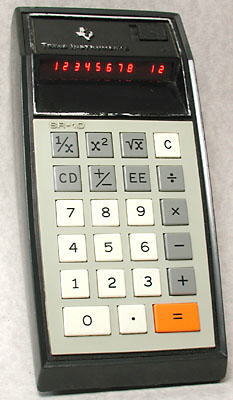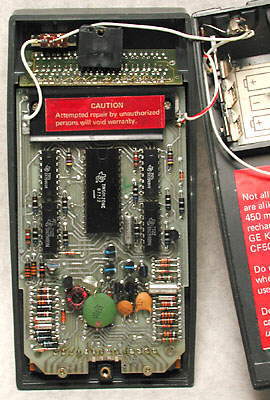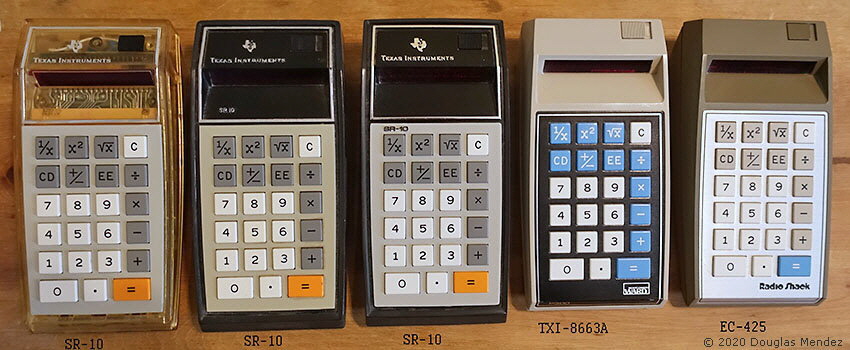Texas Instruments SR-10

Texas Instruments SR-10
Distinctive features: The first of a line of Texas Instruments "Slide Rule" models.
Technical details:Display is red LED, with scientific notation giving 8-digits mantissa and 2 digits exponent.
Semi-scientific "Slide Rule" functions.
Main integrated circuit - Texas Instrument TMS0120NC.
3.6v (3x AA rechargeable cells).
76 x 158 x 37 mm (3.0 x 6.25 x 1.5").
Made in U.S.A.
Introduced in November 1972, with a direct mail price of US$149.95.[1]
Following on a couple of months after its first calculator, the 4-function TI-2500 Datamath, Texas Instruments introduced the SR-10, its first electronic "Slide Rule" calculator.
The journal 'Electronics' reported[1]:
"TI to sell new calculator by mail
Texas Instruments is going to sell a
calculator by direct mail for the first time since it entered the business. And the new merchandising approach will be used for TI's latest machines—the first of a series of hand-held electronic slide rules. The
SR-10 is designed to fill the market gap between simple four-function calculators and Hewlett-Packards HP-35, a complete electronic slide rule. Interestingly, H-P is selling
its calculator successfully through direct mail.
The initial slide rule, the SR-10 is a four-function machine with additional function keys for reciprocals, squares, and square roots. Because both entry
and display can accommodate a two-digit exponent, the new TI calculator can handle eight significant digits in scientific notation through nearly a two-decade range, positive and negative numbers from 1.0000000 x 10-99 to 9.9999999 x 10+99.
Entries in floating point and scientific notation can be mixed, and the calculator will switch automatically to
scientific notation to preserve significant figures.
At $149.95, about half the cost of the HP-35, TI's first electronic slide rule does not offer the trig and reverse trig functions of the H-P model, nor ex, xy, or memory. Entry, however, is arithmetic, as compared to the HP-35's entry scheme.
The SR-10 also features a
12-character, light-emitting-diode display, positive and negative overflow indication, low-battery warning, and an ac adapter/charger can be used for either 60 hertz/115 volt or 50 Hz/220 V operation. It will be available
first off the shelves of retailer Nieman-Marcus."
At the time most scientists and technicians used a mechanical slide rule for calculating, such as the small pocket example below.

The Texas Instruments SR-10 has semi-scientific functions, comparable to the capabilities of a mechanical slide rule, though initially at about ten times the cost. There followed from Texas Instruments, and many other companies, more models of electronic slide rules, with increasing capability and reducing price until within a couple of years the mechanical slide rule became obsolete.

Inside the SR-10 showing the circuit board and the large number of components required at this time.
The main integrated circuit is the Texas Instruments TMS0120NC calculator chip. It is surrounded by four smaller integrated circuits, two SN75493 and two SN75494, which interface the low-current capability of the MOS calculator IC to the high-current requirements of the LED display.

Texas Instruments SR-10 clones and versions made for other companies, from left to right:
- SR-10 prototype with clear plastic casing.
- SR-10 with the 'SR-10' name inside the display bezel.
- SR-10 with the 'SR-10' name at the top of the keyboard.
- Montgomery Ward P300, aka TXI-8663A.
- Radio Shack EC-425.
Grateful thanks to Douglas Mendez for providing this very interesting photograph.
Reference:
Hand-held Calculators
Vintage Calculators
Text & photographs copyright, except where stated otherwise, © Nigel Tout 2000-2026.